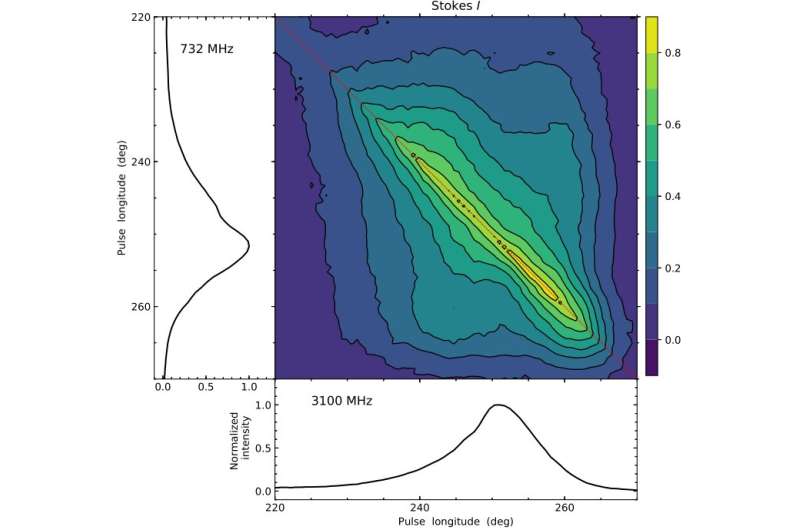Simultaneous single-pulse polarization observations reveal pulsar radiation behaviors

More than 50 years after the discovery of the first pulsar, the detailed physics of the emission process in a pulsar magnetosphere still remains unclear.
The radio emission from pulsars is highly polarized. Simultaneous multifrequency studies of pulsar polarization properties can help to reveal the puzzling pulsar radiation behaviors.
By analyzing the simultaneous single pulse observations using the Parkes 64-m radio telescope at 732 and 3100 MHz, as well as a non-simultaneous observation at 1369 MHz, Rukiye Rejep, a Ph.D. student from the Pulsar Group of the Xinjiang Astronomical Observatory (XAO) of the Chinese Academy of Sciences and her colleagues have conducted a multifrequency study of single-pulse polarization properties of PSR B0950+08.
The study was published in Research in Astronomy and Astrophysics.
PSR J0953+0755 is an early discovered bright pulsar. The researchers found that the low-level bridge emission between the interpulse and the main pulse was observable at 732 MHz.
However, it became very weak or undetectable at higher frequencies. This implied the frequency dependence of the bridge emission which may be common in pulsars with interpulse emission.
In addition, through cross-correlation analysis for simultaneous observations, the researchers found that the total intensity of single pulses was highly correlated between 732 and 3100 MHz. With investigation of the separation values of PA-jumping phase bins, they confirmed that the abrupt PA jumps observed in PSR J0953+0755 were non-orthogonal at three frequencies in this pulsar.
"Furthermore, the separation angle between different polarization modes is frequency-dependent," said Rukiye.
They also found that the dominant polarization modes were associated with negative values of circular polarization, but the association seemed unclear for weak modes.
More information: Rukiye Rejep et al, Simultaneous 50 cm/10 cm Single-pulse Polarization Observations of PSR J0953+0755, Research in Astronomy and Astrophysics (2022). DOI: 10.1088/1674-4527/ac6735
Provided by Chinese Academy of Sciences



















